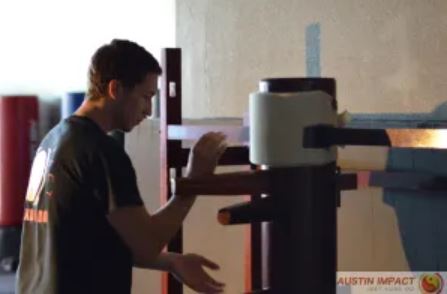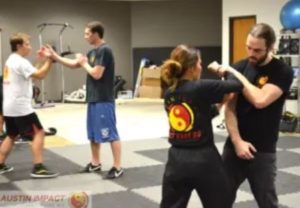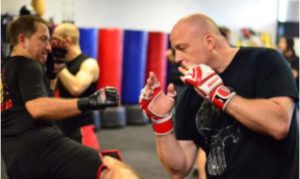BRUCE LEE’S FACTS OF JEET KUNE DO
I am a man who loves lists. I love structure. When I read a “how-to” book I go through the Introduction with a highlighter and highlight anything where the author tells me explicitly WHAT I am going to get out of reading his book, so that I know exactly what to look for.
Thankfully, Bruce Lee was also a fan of lists. He routinely categorized his insights. And in the book, Tao of Jeet Kune Do, Lee shared what he felt constituted his art of JKD.
He titled it “The Facts Of Jeet Kune Do”. This isn’t the only overview that he made of his art, but it is the one that most people have the easiest access to.
It’s also important to keep in mind that he was constantly learning and revising, so this is more of a snapshot of his art at a given point in time. But it is an excellent one and one that I’d like to spend some time looking at. You can find his summary on page 23 (there is a newer edition of the Tao of JKD that might have it on a different page).
I’d like to spend some time breaking down this summary. But first lets look at what he has to say about JKD. So without further adieu here is his list as it is written in his book: THE FACTS OF JEET KUNE DO:
The economy-tight structure in attack and defense (attack: the alive leads / defense: sticking hands).
The versatile and “artless-artful,” “total” kicking and striking weapons.
The broken rhythm, the half-beat, and the one or three-and-a-half beat (JKD’s rhythm in attack and counter).
Weight training and scientific supplementary training plus all-around fitness.
The “JKD direct movement” in attacks and counters–throwing from where it is without repositioning.
The shifty body and light footwork.
The “un-crispy” stuff and unassuming attacking tactics.
Strong in-fighting–
a. shifty blasting
b. throwing
c. grappling
d. immobilizations
All-out sparring and the actual contact training on moving targets.
The sturdy tools through continuous sharpening.
Individual expression rather than mass product; aliveness rather than classicalism (true relationship).
Total rather than partial in structure.
The training of “continuity of expressive self” behind physical movements.
Loose power and powerful thrust-drive as a whole. A springy looseness but not a physically lax body. Also, a pliable mental awareness.
The constant flow (straight movement and curved movement combined–up and down, curved left and right, sidesteps, bobbing and weaving, hand circles).
Well balanced posture of exertion during movement, constantly. Continuity between near all-out and near all-loose.
The first thing you’ll probably notice is that this isn’t a list of techniques. There’s no mention of any actual techniques at all in here. Rather, the emphasis is on the QUALITIES that a student of Jeet Kune Do should possess and on METHODS of training.
This isn’t about techniques because, as Bruce Lee stated, “A punch is just a punch, a kick is just a kick.”
QUALITIES In Bruce Lee’s Jeet Kune Do, he emphasized a fluidity and pliability that allows one to fit in with his opponents. A lot of this is mental.
It’s about staying mentally relaxed and yet poised and ready to attack at a moment’s notice. He sought simplicity of movement, always leaving out anything unnecessary or flowery. Rather, he streamlined everything.
He focused on totality in combat, willing to use any tool he had available to him as a weapon. He stressed footwork. Not just the steps but the constant flow and broken rhythm that one should seek to obtain. He specialized in fighting in really close and felt that was where he was able to be most effective. And overall, he felt that the expressiveness of the individual was key.
METHODS Bruce Lee didn’t separate the martial arts from the martial artist. Weight training and physical conditioning are as much a part of Jeet Kune Do as throwing a punch or a kick. The tools are only as good as the person using them. Sparring is also an integral part of Jeet Kune Do.
Without sparring regularly you are not doing JKD, just like no amount of waving your arms and legs on dry land will make you a swimmer.
JKD is as much about having experiences as it is about learning techniques. And many of those experiences can only come through actually gloving up.
WHERE DO TECHNIQUES FIT IN? JKD is a process of adding and refining, adding and refining.
There are essentially 3 truths about combat that a JKD practitioner accepts and bases his training around:
Anything can happen in a fight.
There is only so much time in the day to train.
The best way to end a fight is usually to end it quickly.
Anything can happen in a fight. Efficiency is anything that scores–even if it’s a Double Flip Spinning Roundhouse Kick (whatever THAT would look like). It CAN work.
I know this sounds a bit silly. But the point is, it is impossible to put “combat” into a box neatly wrapped. That was the point that Bruce Lee was constantly making about getting away from “styles”. As effective as any approach to fighting is, it is still just an approach. And there are an infinite amount of approaches towards fighting. And they all work some of the time.
There is only so much time in the day to train. So the most important thing is to maximize the use of that time. It’s the 80-20 rule.
Although anything can happen in a fight, there are some things that are more common than others, and there are some things that tend to work better than others.
The key is to figure out what those are for you, and then to start practicing those. The best way to end a fight is usually to end it quickly.
This is exemplified in the name Jeet Kune Do itself (“The Way of the Intercepting Fist”). The longer a fight goes on, the less chance you have of coming out unscathed. Although there can be exceptions, the best techniques to spend your limited time practicing are those which will help you end a fight the quickest.
Although you’re always looking to end the fight quickly, this might mean ending the fight before it even gets started, as Bruce Lee did in the boat scene in Enter The Dragon, or it might mean letting your opponent tire himself out for the first part of the fight before you attempt to finish it.
Once these 3 truths have been accepted, the process of adding and refining begins. Since anything can happen in a fight it is important to keep an open mind and to be constantly exploring, examining, and “trying on” new things to see what’s out there.
At the same time, since we only get a limited amount of time in our day to train, we must be constantly refining what we’re learning, boiling it down to only the most important things that are worth our time practicing.
Obviously this will be different for everybody and will require you to think through the most logical scenarios that you might find yourself in.
Essentially what you are doing in this process is developing your very own “style” of fighting–one that fits you perfectly in the moment, one that is flexible and always able to change and adapt as you grow and learn, and one that is truly JKD.



